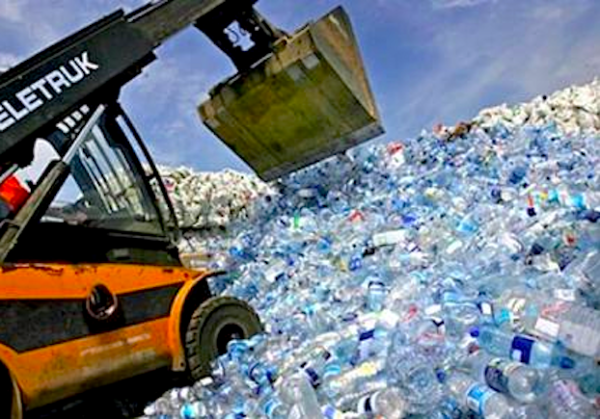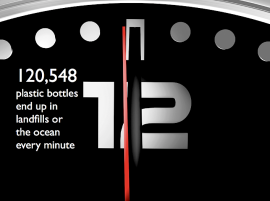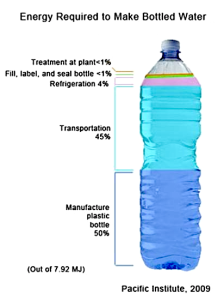Aquafina, Dasani, and Poland Spring are names on the water bottle that have come to evoke images of pristine waterfalls, swift cool streams, and shimmering, unspoiled mountain lakes. As well they should. These three carefully selected names are among the largest selling brands of bottled water in the United States. They play a vital role in the American bottled water industry, an industry which touts the purity and health benefits of its product.
 To be certain, the industry’s marketing strategy has been a resounding success. Once considered a luxury, a “superfluous choice,” bottled water has today become a staple in the American diet. It’s no longer an option; we have come to consider it a necessity. It is now more commonly found in the American refrigerator than a bottle of milk.
To be certain, the industry’s marketing strategy has been a resounding success. Once considered a luxury, a “superfluous choice,” bottled water has today become a staple in the American diet. It’s no longer an option; we have come to consider it a necessity. It is now more commonly found in the American refrigerator than a bottle of milk.
Since records started being kept in 1991, sales and consumption of bottled water have more than tripled. In 2013 Americans consumed over 10 billion gallons of bottled water. Today, 39% of the water we drink is bottled. According to the web site of the International Bottled Water Association,
“When it comes to quenching your thirst, nothing does it better than convenient, healthy, safe, zero calorie bottled water. It is the smart beverage choice. You can count on bottled water when it comes to reliable, safe, and consistent quality.”
The other side of this story: American tap water must meet exacting standards and rigorous tests. It is generally considered the safest in the world.
Cost Out Of Pocket
Somewhere (but not top of mind), we’re all aware of the costs of bottled water. Astronomical, right? Just this astronomical—depending on the brand, quantity, and water bottle size, it can cost from 300 to 2,700 times what we pay for tap water.
While the average cost of tap water is around $.003 a gallon, two-thirds of all bottled water sales (single 16.9 oz. bottles) work out to about $7.50 a gallon—2,000 times the cost of water from the tap. This huge disparity in price is even more striking considering that almost half (over 47%) of bottled water is from the same municipal sources that deliver water to… yes… our faucets.
Environmental Costs of Plastic Water Bottles
 Price is likely the reason more people do not regularly drink bottled water. But there are additional costs that few of us consider when we choose between tap and bottle. The advent of the plastic water bottle has created an environmental toll that far exceeds minor deficiencies in the tap water system.
Price is likely the reason more people do not regularly drink bottled water. But there are additional costs that few of us consider when we choose between tap and bottle. The advent of the plastic water bottle has created an environmental toll that far exceeds minor deficiencies in the tap water system.
EcoWatch estimates that every year, 100,000 marine mammals and up to a million seabirds die after eating or being snared by plastic marine litter. Ninety percent of floating marine debris is plastics.
The plastic in your water bottle is called Polyethylene terephthalate (PET). PET, a petroleum-based plastic, is considered safe for human use and is easily recycled. But the environmental costs of using PET are very high. According to the peer-reviewed and respected 2009 study by the Pacific Institute, the production of 8.2 million gallons of bottled water in the United States:
- Required nearly 900,000 tons of PET.
- Consumed the equivalent of 17 million barrels of oil—enough to fuel 400,000 cars for one year.
- Emitted 2.5 million tons of carbon dioxide, our most common greenhouse gas.
The bottled water industry has in part addressed this concern: water bottles today use less PET than those we drank from in 2006 (have you noticed how squishy the newer bottles are?). But bottled water sales have been accelerating. In 2013, over 10.1 million gallons of of bottled water were sold in the US, a 13% increase over 2006.
Tap water is piped from the source to the consumer. Nearly all bottled water is transported by truck:
- 56% of bottled water is derived from non-municipal sources and requires transport from the source to the processing facility.
- Bottled water is trucked from the processing plant, to the distribution center, and then to the the retail outlet.
- More than 1 billion bottles of water are transported in the U.S. every week by truck, rail, or ship.
The Pacific Institute calculated that the total energy output involved in the production of bottled water in the US, including production of plastic bottles, shipping, and cooling, was between 32 and 52 million barrels of oil, a staggering 2,000 times the energy cost of producing tap water.
Recycling Plastic Water Bottles
Recycling of PET bottles has also increased in the last few years. This may sound impressive and hopeful, but consider that the rate of recycling all PET water bottles and jars in the U.S. stands at about 31%.
Sounds good? That’s 2-1 in favor of the trash can. In 2012, 9.3 billion water bottles were recycled, but 20.7 billion were thrown out—a rate of 56.7 million discards daily.
 Now, the CO2 output in the production of a water bottle using recycled PET (rPET)is 65% less than using that of using virgin plastic, and the cost is 20% less. But in 2011, only 4.4% of all food and beverage containers in the US were made with rPET. Instead, our recycled plastic was sold to burgeoning lucrative markets for new products, including plastic clothing, packaging, and industrial carpeting. 34% of US rPET is sold overseas.
Now, the CO2 output in the production of a water bottle using recycled PET (rPET)is 65% less than using that of using virgin plastic, and the cost is 20% less. But in 2011, only 4.4% of all food and beverage containers in the US were made with rPET. Instead, our recycled plastic was sold to burgeoning lucrative markets for new products, including plastic clothing, packaging, and industrial carpeting. 34% of US rPET is sold overseas.
Because PET does not biodegrade, it can remain almost indefinitely in landfills. Sixty million water bottles daily (more than 4 billion pounds a year) end up in our landfills. PET does degrade after prolonged exposure to sunlight and water. But in doing so, it breaks up into small flakes that find their way into our waterways. According to the Ocean Conservancy,
“[P]lastic bottles and plastic bags are the most prevalent form of pollution found on our beaches and in our oceans. Every square mile of the ocean has over 46,000 pieces of floating plastic in it.”
Go Back To The Tap
Next time you consider buying a liter of bottled water, remember that you are really paying more than twice the price per gallon of a gallon of gas. And remember what else went into that bottle.
Imagine that water bottle one-quarter full of oil. That oil represents the amount of petroleum used in the packaging, distribution, and cooling of a single bottle of water. Recycle it, and more energy will be consumed and it might leave the US manufacturing cycle. Put it in the trash, and it will remain in the landfill for hundreds of years. Discard it, and chances are that your careless junk will end up in the nearest stream, river, or ocean.
Try a filter for your faucet if you still mistrust the tap. The next time you walk out the door, fill up your reusable water bottle in your own kitchen. You’ll be pleased with your water’s purity and taste. Your budget will get a break, and the earth will breathe just a little bit easier.
This article comes to you from regular PlanetSave reader and guest contributor Scott Whitaker, via Sandy Dechert.
